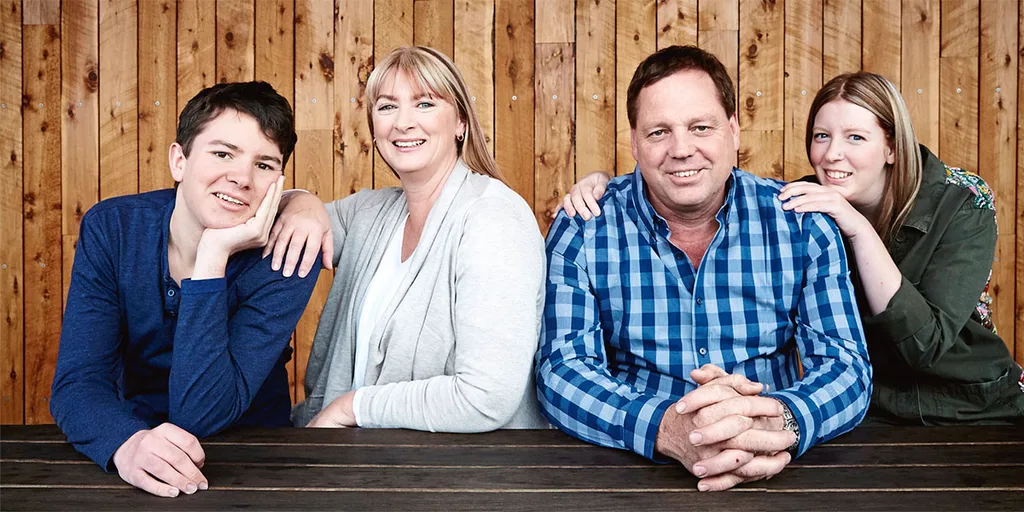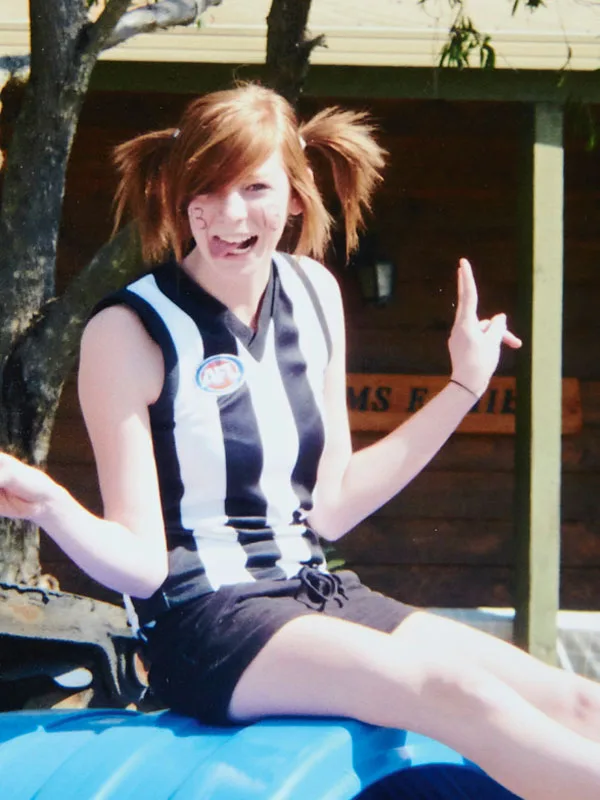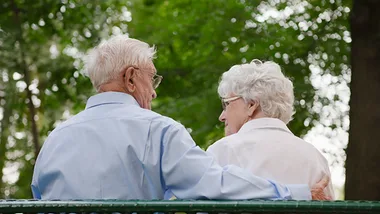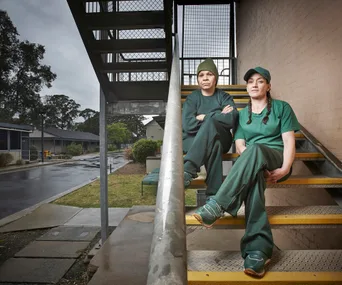For most of his adult life, Andrew Adams, a husband and father of two, primed himself for what he thought was a worst-case scenario.
After watching his mother nurse his dad to an early grave at 62 following a protracted battle with early onset Alzheimer’s and witnessing his grandfather and uncle suffer the same fate, Andrew figured it was only a matter of time before the disease claimed him, too.
And so he worked hard. He threw himself into the trucking business he had built and now manages with his wife, Kellie, determined to secure the future for his small family before his mind started to degenerate.
Yet when early onset dementia found Andrew’s household in country Victoria, as he knew it inevitably would, it completely blindsided him. It was his two children, Aaron and Taylor, who had succumbed and the disease hit with such suffocating force that almost overnight Kellie and Andrew’s precious, happy, outgoing kids had all but disappeared.
“Andrew worked hard to set up the family because in the back of his mind he was next – that’s the way the pattern went,” says Kellie, wiping away tears. “We never imagined it would be the kids.”
In 2013, not long after his 16th birthday, Aaron Adams was diagnosed with Niemann-Pick Type C disease (NPC), or childhood Alzheimer’s as it is known. Just five weeks later, his sister Taylor, then 19, was diagnosed with it, too. With no known cure, childhood Alzheimer’s is simultaneously robbing them of their past and their future.
“We literally woke up one day and Aaron couldn’t speak anymore,” Kellie says. “Our gorgeous bright, happy teenage boy was gone. Then Taylor, too. We are watching our children slowly die and there’s nothing we can do to stop it.”
When Aaron was 11 years old, Kellie and Andrew began to wonder if something was wrong with their youngest child. Aaron had always been a bright young boy, two years ahead of his peers in reading and on the verge of achieving a karate black belt. Both Aaron and Taylor played badminton at state level and they were widely known in the community as talented, energetic kids.
Andrew says he always knew his son was smart. “I used to take him out in the truck with me when he was a little fella and he’d read road signs and names that I struggled with.”
So they became alarmed when Aaron suddenly began having difficulty reading.
A specialist diagnosed “learning difficulties” Kellie says, but it was difficult to swallow.
“He’d never had a learning difficulty in his life – quite the opposite.”
It would be six long, frustrating and at times heartbreaking years before they got an accurate diagnosis about what was happening to their son.
“We could see him going backwards. At 10, he could tie a fishing knot. By the age of 11, he couldn’t,” Kellie says. “We were camping and my dad came up to me and said, ‘What’s happening with Aaron’s memory?’. We went camping all the time and he’d asked him to do something routine and Aaron couldn’t do it. That made us really sit up and take a lot more notice. On a day-to-day basis, small things were bothering us, but my father hadn’t seen Aaron for a while and to him the decline was really noticeable.”

From their home in Bendigo, Kellie and Andrew beat a path to every doctor and specialist’s door they could find. They visited GPs, paediatricians, neurologists, psychologists, naturopaths, even hypnotists and Chinese herbalists.
In the back of her mind, Kellie was terrified that Aaron had Alzheimer’s and she repeatedly shared her concerns and the family history with doctors.
“I was dismissed every time. The doctors would say, ‘No, it can’t be that. He’s too young.’ Between the ages of 11 and 13, we had a number of blood tests, we had scans, we had every test imaginable and they’d all come back saying he was ‘normal’, there was nothing wrong,” Kellie says. “We were beside ourselves and we were so frustrated because we could see something was wrong. We were screaming out for help, beating our heads against a brick wall, but no one would listen.”
Bit by bit, they noticed Aaron struggled to walk up and down stairs, he could no longer ride his favourite mini-bike around the backyard and he was at times unable to feed himself.
Taylor also began to have some issues, but they put it down to the challenges of teenage years and the death of a close family friend, one of their own truck drivers, in a terrible accident that happened around the same time.
“It was horrific for the whole family and we could see it was having an impact on Taylor and Aaron,” says Andrew.
“The kids were very shaken up and became quite anxious afterwards.”

Aaron and Taylor were both fun-loving and athletic children before the disease cruelly struck.
Kellie took Aaron to see a child psychologist, who suggested that Aaron might be shutting himself down due to the stress of the accident. She was referred to a hypnotherapist to see if they could release the anxiety that may have been causing him to withdraw from the family.
Yet on the very morning they were due to visit the hypnotherapist, Aaron stopped speaking. He has been unable to manage more than a few basic words since.
“That morning, I sat in the clinic with the doctor, crying my eyes out while Aaron just stared at her blankly,” Kellie says. “He couldn’t say a word, he was like a caveman. She tried everything to get him to talk, but he couldn’t. I apologised to her for crying and she said,
‘Don’t apologise, you are grieving’. She said, ‘Your child is disappearing before your eyes and you can’t do anything about it.’ And she was right.”
By mid-2013, Aaron was no longer able to attend school and the Adams family were increasingly desperate to find an answer. One afternoon, while Aaron was watching a movie, Andrew noticed him thrashing around on the sofa – he had no control over his movement. It was the final straw. They packed their bags and headed to The Royal Children’s Hospital in Melbourne for what seemed like the hundredth time. This time, though, they were determined they wouldn’t leave until they got help.
“I would have slept on the hospital floor,” Kellie says.
A team of neurologists and specialists finally diagnosed Niemann-Pick Type C disease, a rare and aggressive form of juvenile dementia. NPC typically mirrors the symptoms of older Alzheimer’s sufferers, including loss of memory, difficulty walking, lack of muscle control and a decline in motor skills. Plus, it is fatal.
Sadly, Kellie had been right all along.
“When we got the actual diagnosis, it was such a mixture of emotions,” she says. “Some weight was lifted because we finally had an answer to what was wrong and a direction to head in, but we were also heartbroken. We’d look at Aaron sitting on the sofa and it looked like he was an 80-year-old man.”

“In hindsight, of course, we can see that around 16, she started to really develop the symptoms.” Taylor before her diagnosis.
After Aaron’s diagnosis, they immediately had Taylor tested to see if she was a carrier of the gene.
They were devastated to learn that she not only had the gene, but was in the advanced stages of the disease.
Within a week, Taylor suffered a breakdown, from which she has never recovered.
“I think her breakdown was due to the pressure she was under knowing what was to come,” says Kellie. “Taylor and Aaron were very close. I think she’d watched what was happening to her brother and the prospect of the same thing happening to her was too much.
We went from one child with NPC to two in a matter of weeks. From the day Taylor had her breakdown, we never really got our daughter back.”
Diagnosis of NPC can be difficult, but in hindsight, Kellie and Andrew say there were signs. Moreover, they are certain that despite the rarity of the disease, other children may also be suffering without an accurate diagnosis.
“With Taylor, there were ongoing issues, but we put a lot of it down to teenage years,” says Kellie. “In hindsight, of course, we can see that around 16, she started to really develop the symptoms. The first real sign was that she was choking on air – out of the blue, she’d begin to choke on nothing – and it would take her a while to get over it and breathe normally. The doctors looked down her throat, but couldn’t see anything – now we know that that is a sign. Kids with NPC have trouble swallowing food and can eventually hoke on it. We had no idea at the time.
“Her vision deteriorated rapidly, too. But my mum wore glasses at an early age, so we put it down to something that was in the family. Now we know that both Taylor and Aaron actually had vertical gaze palsy, where your sight is restricted because you can’t look up or down without moving your head.”
“Taylor was a good wake-boarder,” Andrew adds, “and we’d often go up to the Murray River skiing. We noticed that she was getting wider and wider when she skied, close to the banks of the river where there are snags and trees, but she couldn’t see. Aaron was struggling to walk up and down stairs – we thought he’d become scared of heights. Now that we have a diagnosis, we are working through a reverse jigsaw puzzle, putting all of the pieces in place, and we are able to see the trigger points along the way that were invisible to us at the time.”
Kellie wipes away tears and as she thumbs through photos of the two kids before NPC hit, it’s almost impossible to imagine that the vibrant boy doing karate and the beautiful young ballerina striking a pose are the same young people who now hardly recognise their parents.
In Australia, there is a one in 200 chance of being a carrier of the defective gene that causes NPC, and one in 120,000 children will be born with the disease.
Aaron and Taylor inherited two copies of the defective gene, one from each parent. “Both Kellie and I carry the gene,” Andrew explains. “The chances of that are so rare, it’s like we’ve won the worst lotto draw you can imagine.”
Today, Aaron and Taylor require 24-hour care. They need help to shower, dress and eat, and are suffering such significant memory loss they won’t remember a movie immediately after they’ve watched it. NPC is fatal and although the life expectancy for Aaron and Taylor is unclear, most sufferers die within five to 10 years of diagnosis.
Kellie and Andrew are acutely aware that time is not on their side. They are determined to care for their children at home as long as they can, but are grateful for the help from family and respite carers. The Adams family has quietly and stoically battled this disease behind closed doors, but they are sharing their story in the hope of raising awareness of NPC and vital funds needed to support research being conducted by Dr Ya Hui Hung, at the Florey Institute in Melbourne.
“It’s too late for us and our children, but our situation might help find a cure for someone else and not just young people with NPC, but older people who suffer Alzheimer’s, too. Maybe Aaron and Taylor’s lives can save someone else,” says Andrew, before pausing. “What burns me up is that you see perfectly healthy kids who throw away their lives taking drugs like ice and then you have our kids who, through no fault of their own, have no future. It’s just not fair. But we’ll never give up on our kids and we’ll fight every inch to find a cure.”
QUEST FOR AN NPC CURE
The Florey Institute is the only place in Australia researching a cure for NPC, but Dr Ya Hui Hung’s work receives no government funding. There are 25 known NPC sufferers in Australia, but there may be many more who are yet to be properly diagnosed.
NPC causes deterioration of the brain, similar to Alzheimer’s disease, as it develops a build-up of beta-amyloid protein and fibrous tangles. In addition, the body’s cells have problems handling metals and cholesterol. Dr Hung says the disease is commonly misdiagnosed as learning disabilities, schizophrenia or psychosis.
The families of diagnosed children have established the Australian NPC Disease Foundation to raise awareness of the disease and much-needed funds for research, but it is a race against time. Dr Hung is currently testing new drugs using skin cells from patients.
To make a tax-deductible donation or learn more about the disease and its symptoms, visit florey.edu.au or phone 1800 063 693.
A video you might also like: John Travolta has eyebrows raised in his new show The People V OJ Simpson



